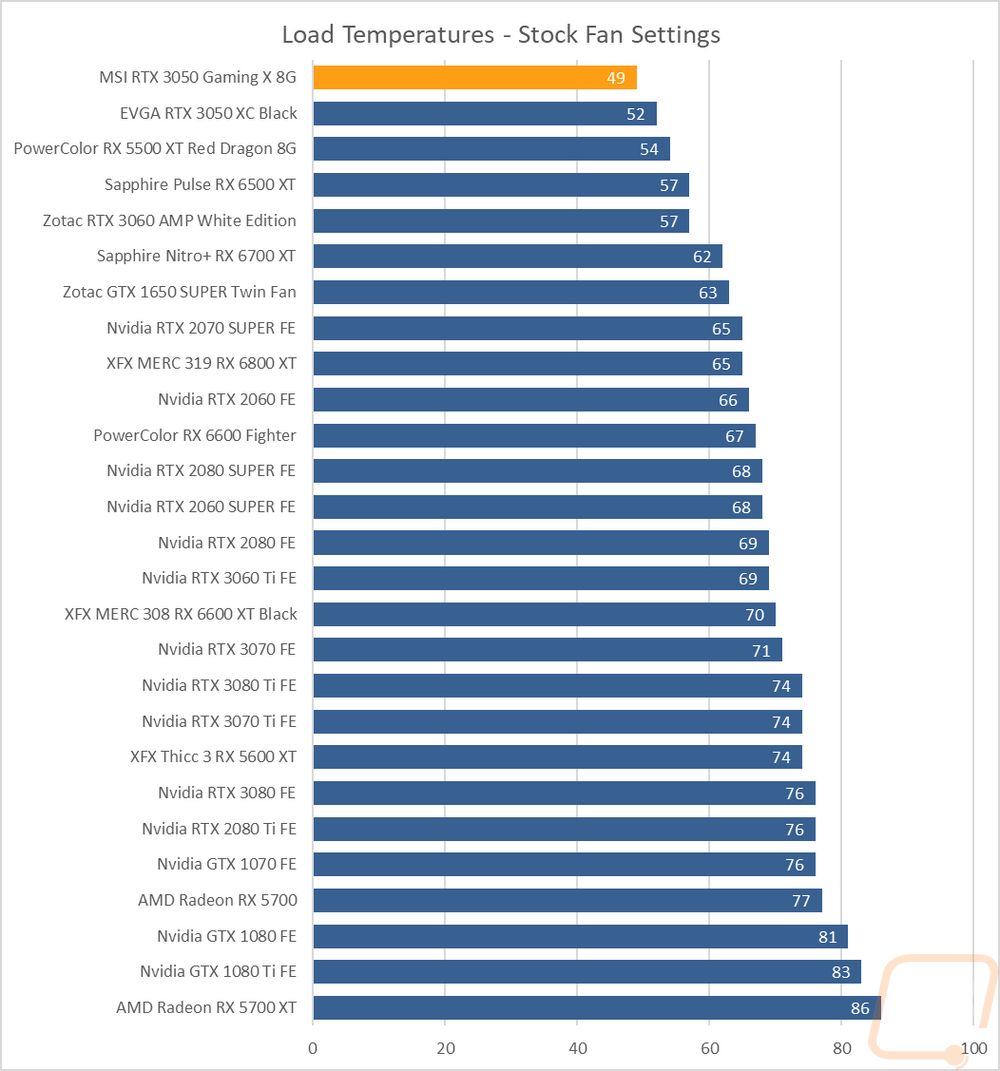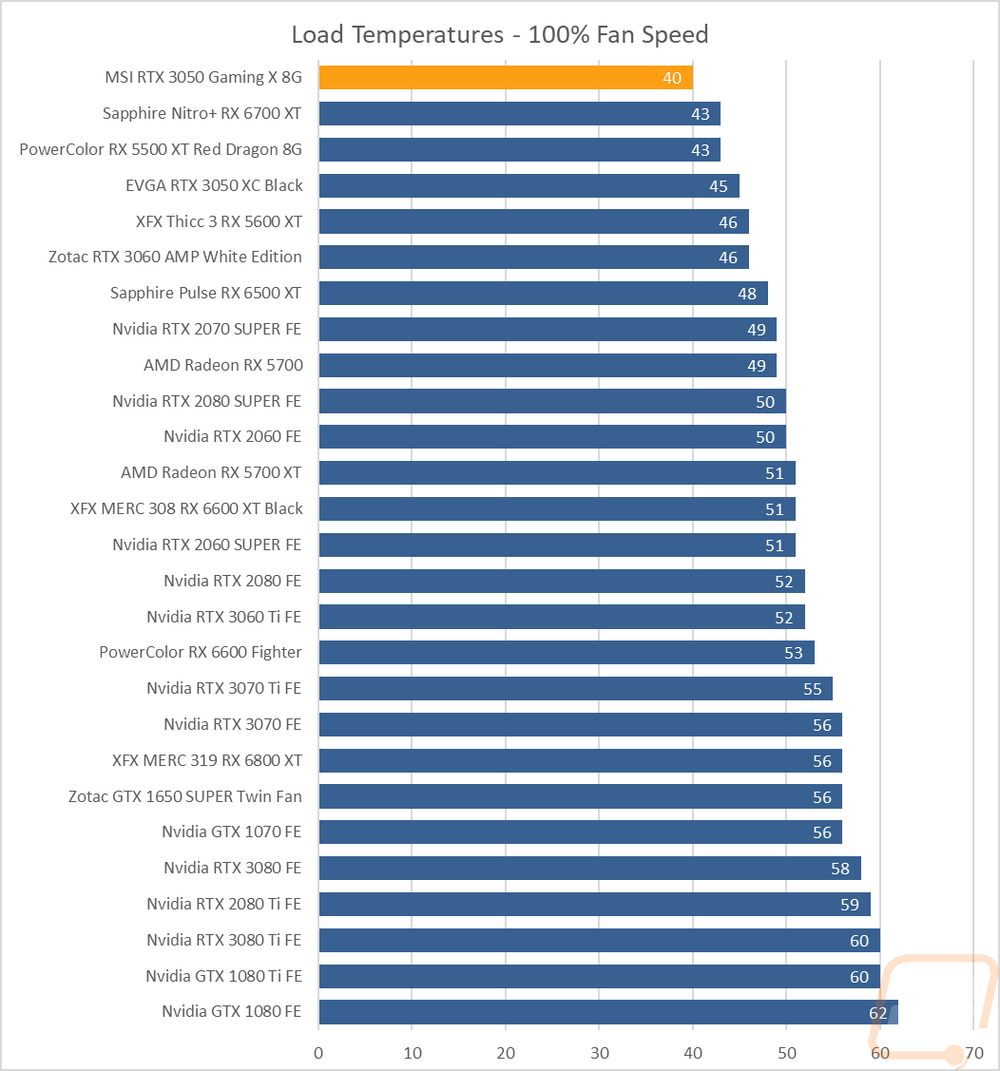Cooling Noise and Power
For my last few tests, rather than focusing on in game performance, I like to check out other aspects of video card performance. These are also the most important ways to differentiate the performance between cards that have the same GPU. To start things off I took a look at power usage. For this, I use our Kill-A-Watt hooked up to the test bench to record the total wattage of the system. I ran two tests with the first using 3DMark Time Spy to put the system under a load similar to normal in game performance. Here our test system with the 3050 Gaming X pulled 252 watts which was exactly the same as the stock RTX 3050. At the same time with Time Spy I also use GPUz to check out the onboard reading for GPU power draw at the chip. On that result, the 3050 Gaming X does show that it is pulling 3.6 more watts to the GPU itself over the stock 3050. Lastly, I run AIDA64’s stress test on the video card to load up only the GPU, and using the Kill-A-Watt the test bench with the 3050 Gaming X was pulling 222 watts. That is 12 more watts than the stock RTX 3050 and enough to push it up over the RX 6600.



My next round of tests were looking at noise levels. These are especially important to me because I can’t stand to listen to my PC whirling. Especially when I’m not in game and other applications are using the GPU. For my testing, though I first tested with the fan cranked up to 100% to get an idea of how loud it can get, then again at 50% to get an idea of its range. I test using both A and C weighting, A is the standard way and C has a little more of the low end to check for low-level hums. The 3050 Gaming X didn’t do all that well in the 50% fan speed chart with it coming in at 42.7dB in the A-weighted test. When the fans were turned up to 100% it did do better, however. I also take a look at noise performance while under load. For that when running AIDA64’s stress test I wait until the temperature of the card has leveled off and then measure how loud things are when the card is at its worst-case scenario with the stock fan profile. Here the 3050 Gaming X did extremely well and was the quietest card tested.




To finish up my testing I of course had to check out the cooling performance. To do this I ran two different tests. I used AIDA64’s Stress Test run for a half-hour each to warm things up. Then I documented what temperature the GPU leveled out at with the stock fan profile and then again with the fans cranked up to 100%. With the stock profile, I was really surprised to see that the 3050 Gaming X was running cooler than any other card tested. Not that I didn’t think it was capable of doing that. But with the under load noise testing result being so good I thought that MSI had maybe sacrificed a little cooling with their fan profile but that wasn’t the case. Then with the fans cranked up, the 3050 Gaming X was once again the coolest card tested, sitting ahead of everything else by 3 degrees. Together we can see there is still headroom in the cooler, even with the stock profile running so cool.



When doing the stock fan profile testing I did see a couple of quirks, nothing that would be a big concern at all but I did want to point them out in case anyone else runs into them. The 3050 Gaming X has what MSI calls Zero Frozr which is where the fans don’t turn on until you are putting the card under load. I love this feature because no matter how quiet a fan is it does still make some noise. Normally the fan will come on as things heat up before the card reaches its “stable temp”. But the 3050 Gaming X waits a little longer. So our card when under the AIDA64 stress test would level out at 49c with the stock fan profile. But before getting there the fans actually won’t turn on until it reaches 62c so you will see a spike in temperatures ahead of the cooling coming on. You can see it below with the lines where I turn the test on and off. I suspect that with some games or workloads that aren’t always at 100% load like this stress test you might see the 3050 Gaming X running at the higher temperature a lot more. Beyond that after around 20 minutes I would also see the fans just turn off and heat back up and cool back down again, this happens consistently over and over if I leave the workload on. Again, this isn’t heating things up enough to be a concern at all. It is just a little inconsistent with what I’ve seen other cards that turn the fans off do most likely because the 3050 Gaming X runs cooler than most cards. I would bet that if the fan turn on point was under 49c we wouldn’t see this quirk.

While running the stock fan profile testing I also took the time to get a few thermal images so we could see what is going on. Starting on the fan side, the 3050 Gaming X is running cool. The hottest spot on this side is down on the SSD below the card, which the 3050 Gaming X does contribute to that heat with the hot air from the card blowing down into that area. That view shows the bottom half of the heatsink is warmer than the top, most likely with the top having an easier airflow path. The left side which has the VRM and a little more of the GPU also makes that side a little warmer, the right side also has the blow-through ventilation that helps as well. Up on the top edge, you can see where some of the heat is being blown out of the top. Then with the backplate view, we can see that the GPU side of the card is transferring some heat through the backplate and out.





